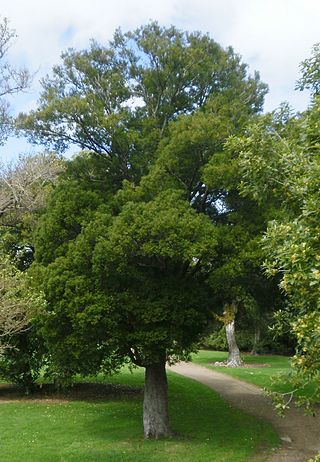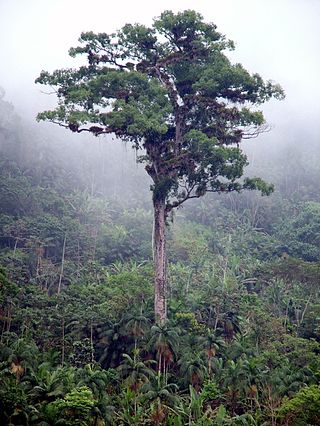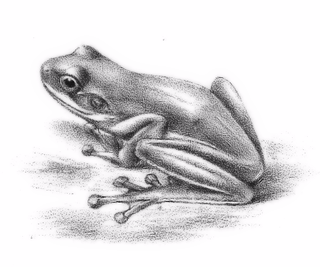
Prumnopitys taxifolia, the mataī or black pine, is an endemic New Zealand coniferous tree that grows on the North Island and South Island. It also occurs on Stewart Island/Rakiura but is uncommon there.

Prumnopitys is a genus of conifers belonging to the family Podocarpaceae. The nine recognized species of Prumnopitys are densely branched, dioecious evergreen trees up to 40 metres in height.

Mount Chirripó is the highest mountain in Costa Rica, with an elevation of 3,821 meters. It is part of the Cordillera de Talamanca, and the range's highest point. It is located in Chirripó National Park and is noted for its ecological wealth. The mountain was named "Chirripo", meaning "land of eternal waters", by indigenous Costa Ricans because there are many lakes and streams around the mountain. The high peaks in Chirripó National Park and La Amistad International Park host important areas of Talamancan montane forest and Costa Rican Páramo with high endemism and extremely high biodiversity. The peaks of these mountains constitute sky islands for many species of plants and animals. Snow has not fallen on the peak in the past 100 years or so, according to the University of Costa Rica, but hail is sometimes reported.

Lake Arenal is a lake which is situated in the northern highlands of Costa Rica. It is currently the largest lake in Costa Rica at 85-square-kilometre (33 sq mi). Its depth varies between 30 and 60 meters (100–200 feet) seasonally.

The short-eared bat is a bat species found in Brazil, Costa Rica, Guyana and Nicaragua. It is the only species within its genus.

Ulmus mexicana, the Mexican elm, is a large tree endemic to Mexico and Central America. It is most commonly found in cloud forest and the higher elevations of tropical rain forest with precipitation levels of 2–4 m (79–157 in) per year, ranging from San Luis Potosi south to Chiapas in Mexico, and from Guatemala to Panama beyond. The tree was first described botanically in 1873.
The slender harvest mouse is a species of rodent in the family Cricetidae. A small mouse-like rodent distributed throughout a portion Central America.

Cariniana legalis is a species of emergent rainforest tree in the Monkeypot family Lecythidaceae. It is found in the Atlantic forest of south-eastern Brazil, where is known as jequitibá-branco or jequitibá-rosa, and possibly found in Colombia, and Venezuela. These trees can be very large. A C. legalis measured by botanical explorer David Fairchild was 62 feet in circumference with no buttresses at six feet above ground.

Juniperus standleyi is a species of juniper native to Guatemala and the adjacent extreme southeast of Mexico, where it occurs at elevations of 3,000–4,250 metres. Its local common names include huitó, cipres, and huitum.

The Costa Rica brook frog or red-eyed stream frog is a species of frog in the family Hylidae found in Costa Rica and Panama. Its natural habitats are tropical moist lowland forests, subtropical or tropical moist montane forests, and rivers between 70 and 1740 meters above sea level.
Pristimantis altae, also known as mountain robber frog, is a species of rain frog in the family Strabomantidae with a bright coral-coloured groin. It is found in Costa Rica and Panama.
Lithobates vibicarius, commonly known as either green-eyed frog or Rancho Redondo frog, is a species of frog in the family Ranidae from highland rainforests in Costa Rica and western Panama.

The bare-shanked screech owl is a species of owl in the family Strigidae. It is a large owl that feeds at night in forests and lives in a family size group, even during breeding season. The owl's range is only in Costa Rica, Panama, and far northwestern Colombia. The owl preys on large insects, shrews, and small rodents.

The Talamancan yellow-shouldered bat is a species of bat in the family Phyllostomidae. It is found only in Costa Rica and Panama, and there are no subspecies.

Dice's cottontail is a species of cottontail rabbit in the family Leporidae. It is found in Costa Rica and Panama, in páramo and cloud forest habitats.

Quercus benthamii is a species of oak in the family Fagaceae. It is native to the cloud forests of Central America and southern Mexico. It is threatened by habitat loss.
Mora megistosperma also called Mora oleifera is a species of rainforest tree in the Bean Family (Leguminosae, or Fabaceae and in the Cassia subfamily Caesalpinioideae. It is commonly called Mora or Mangle Nato It is found in Costa Rica, Panama Colombia and Ecuador. It grows 147 feet in height and up to thirteen feet diameter at breast height. It is most noted for producing the largest seeds of any Dicot plant ; and up to 7 inches long by six inches wide, and up to four inches thick. and can weigh up to 2.2 pounds. and is exceeded only by Lodoicea and Cocos nucifera var. gigantea. The white flowers are in little spikes about five inches long. The leaves are paripinnate with just two pairs of ovate or oblong leaflets, each leaflet up to seven inches long.

Pectinopitys is a small genus of conifers from South America and Oceania belonging to the podocarp family, Podocarpaceae. It was split out from the Prumnopitys complex by Christopher Nigel Page in 2019 and is still considered as closely allied to this genus and Sundacarpus.














